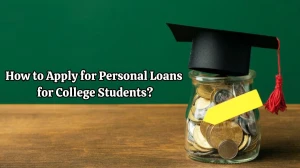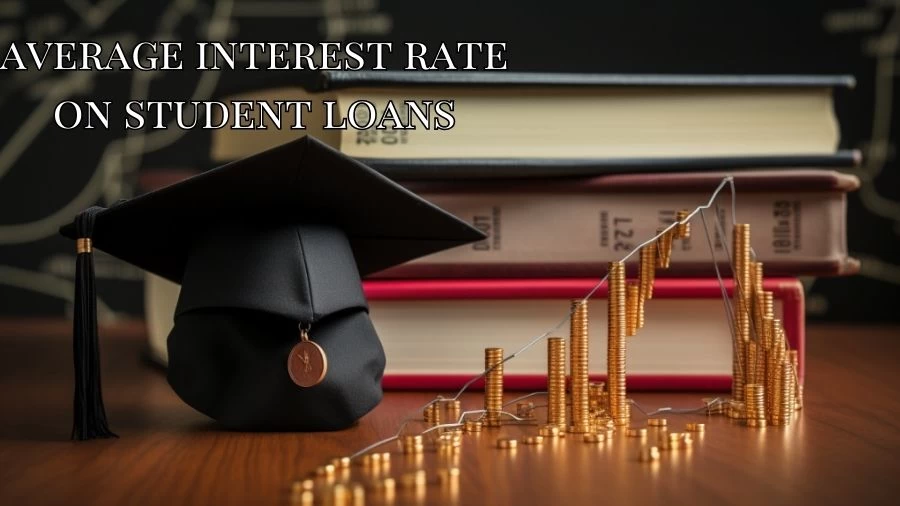
Average Interest Rate on Student Loan, Average Federal Student Loan Interest Rate
Encompassing federal and private loans, historical trends, recent changes, and different loan categories, the content delves into student loan interest rates.
by Sai V
Updated Aug 19, 2023
On This Page
- Average Interest Rate on Student Loans
- Average Federal Student Loan Interest Rate
- Average Student Loan Debt
- How is the Functioning of Student Loan Interest Rates Explained?
- What Are the Existing Interest Rates for Student Loans?
- What Sets Apart Subsidized and Unsubsidized Student Loans?
- What Are the Distinctions Between Fixed Rates and Variable Rates?
- What Strategies Can Be Employed to Lower the Interest Rate on My Student Loans?
- What Are the Steps to Settle Accrued Interest on a Student Loan?
Average Interest Rate on Student Loans
Overview of Student Loan Interest Rates
- The average interest rate for student loans is an essential metric that encompasses federal and private loans.
- Federal student loans have fixed interest rates, while private lenders offer a range of interest rates for refinancing.
Federal Student Loan Interest Rates
- Federal student loan interest rates vary based on the type of loan and the borrower's status.
- Current federal interest rates for different types of loans are as follows:
- Undergraduate Direct Loans: 4.99%
- Graduate & Professional Direct Loans: 6.54%
- Parent, Graduate & Professional PLUS Loans: 7.54%
- Federal loan interest rates have been temporarily set to 0% until June 30th, 2023.
- 92.7% of total student loan debt is federal.
Recent Trends in Student Loan Interest Rate
- Student loan interest rates experienced historic lows during the 2020-2021 academic year.
- From 2020-21 to 2021-22, federal student loan interest rates increased by an average of 24%.
- Undergraduate loan interest rates increased 15% faster compared to graduate and professional student loans.
- The undergraduate federal interest rate decreased by 80.36% since its peak in the early 1980s.
Historical Federal Interest Rates
- Federal student loan programs originated in 1944, initially available exclusively to military veterans.
- Interest rates reached a high of 12% in 1982 and subsequently underwent a gradual decrease.
- Notable historical interest rates include 9% for undergraduates in 1988 and a range of 7% to 10% in 1992.
- Between 2010 and 2020, federal interest rates experienced an average decline of 33%.
- The average federal loan interest rate has reduced by 50.4% since 2006.
- The interest rate for Direct Unsubsidized Loans for undergraduates was 6.8% from 2006 to 2013.
- Graduate and professional students lost eligibility for subsidized loans from July 1, 2012.
Interest Rates for Graduate, Professional, & Parent Loan
- Interest rates for these categories of loans haven't decreased as rapidly as those for undergraduate loans.
- Over recent years, interest rates for these loans have increased, albeit at a slower pace compared to undergraduate loans.
- There have been significant year-over-year declines in interest rates between specific academic years.
Average Federal Student Loan Interest Rate
The average interest rate for federal student loans serves as a crucial factor to comprehend when considering educational financing. These loans offer a means of addressing financial gaps that may arise when scholarships, grants, and other forms of financial aid do not cover the full extent of expenses. However, it's essential to recognize that these loans come with additional costs beyond the principal amount borrowed, as they accrue interest over time.
The interest rates associated with federal student loans significantly impact the overall amount that borrowers will eventually need to repay. For the current academic year, undergraduate students face an interest rate of 5.50 percent, while graduate students encounter higher rates of 7.05 percent or 8.05 percent for unsubsidized loans and Direct PLUS loans, respectively. This underscores the importance of thorough research and comparison before selecting a loan, ensuring that the chosen loan aligns with one's financial capacity and post-graduation repayment capabilities.
Average Student Loan Debt
Overview and Average Debt
- In 2021, student loan debt in the US was highlighted.
- The average student loan debt was $37,338, showing slower growth compared to previous years.
Federal vs. Private Student Loan Debt
- Federal student loan debt averaged $37,338 per borrower.
- Private student loan debt was higher, with an average of $54,921 per borrower.
- On average, students borrowed over $30,000 to pursue a bachelor’s degree.
Borrower Statistics
- Around 45.3 million borrowers held student loan debt.
- The majority (92%) of these borrowers had federal loan debt.
Long-Term Debt
- After twenty years of entering school, half of student borrowers still owed $20,000 each in outstanding loan balances.
Growth in Student Loan Debt
- Between Spring 2021 and the present, average student loan debt increased by 2.74%.
- Federal student loan debt saw a 5.9% increase since Fall 2020 (from $36,520).
- Private student loan debt decreased by 14.58%, largely due to Wells Fargo's departure from the student loan market.
Monthly Payments and Post-Graduation Debt
- The median monthly payment for student loan holders was $250.
- Graduates owed an average of $33,500 a year after leaving school.
- Private nonprofit university students carried an average debt of $33,700 for a bachelor's degree.
- For-profit students borrowed even more, averaging $49,700.
- All postsecondary students, including those earning certificates and associate's degrees, borrowed at least $15,000 to cover their classes.
State Variations
- Some states showed variations in student loan debt.
- Alaska had the highest increase, with an additional $1,269 in average federal student loan debt per borrower.
- Delaware followed with a 23% lower increase of $1,101 per borrower.
- Wyoming exhibited the largest nationwide decrease, with student loan borrowers reducing their average debt by $793 each.
- Vermont's student loan debt declined by $622 per person, approximately 22% of Wyoming's decrease.
- Iowa and New Hampshire had minor declines of $9 and $13 per borrower, respectively.
How is the Functioning of Student Loan Interest Rates Explained?
How student loan interest rates operate can differ based on whether the loan is provided through federal programs or by private lenders. Here's an overview of how these mechanisms work:
Federal Student Loans:
Interest Rate Determination: The interest rates for federal student loans are established annually by Congress, and these rates are influenced by the 10-year Treasury note. This implies that every student borrower obtaining the same type of federal loan within a specific year will face the same interest rate.
Associated Fees: Most federal student loans come with fees, which are a percentage of the total loan amount. These fees are subtracted from the loan disbursement before it's given to the borrower.
Fixed Rates: Federal student loans are typically associated with fixed interest rates. This signifies that the interest rate remains unchanged over the duration of the loan, offering borrowers a stable and predictable monthly payment structure.
Private Student Loans:
Interest Rate Calculation: Interest rates for private student loans generally hinge on the borrower's creditworthiness. Individuals with higher credit scores are more likely to secure lower interest rates, while those with lower credit scores might be offered higher rates to account for perceived higher risk.
Origination Fees: A considerable number of private lenders do not levy origination fees. These fees are upfront charges associated with processing the loan application. The absence of origination fees can be advantageous for borrowers, reducing the initial borrowing costs.
Fixed vs. Variable Rates: Private student loans grant borrowers the option to pick between fixed and variable interest rates.
- Fixed Rates: If a borrower selects a fixed interest rate, it remains constant throughout the loan's lifespan, akin to federal loans. This ensures consistency in monthly payments.
- Variable Rates: Opting for a variable interest rate links the rate to a benchmark interest rate, such as the prime rate or LIBOR. Variable rates can change either monthly or quarterly, contingent on the loan agreement's terms. Although these rates might initiate at lower levels than fixed rates, they possess the potential to rise over time, causing fluctuations in monthly payments.
What Are the Existing Interest Rates for Student Loans?
The current interest rates for student loans exhibit a distinction between federal and private loans. Approximately 92 percent of student loan debt comprises federal loans, which carry interest rates ranging from 4.99 percent to 7.54 percent. Conversely, private student loan interest rates span a wider spectrum, fluctuating between just under 4 percent and nearly 15 percent. Federal loan rates remain uniform for all borrowers, whereas private loan rates are contingent on factors including the lending institution, the type of interest (fixed or variable), and the borrower's credit score.
|
Type of Loan |
Borrower Group |
Fixed Interest Rate |
Loan Origination Fee |
|
Federal Direct Subsidized Loans and Unsubsidized Loans |
Undergraduate Students |
4.99% |
1.057% for loans originated between Oct. 1, 2020, and Oct. 1, 2023 |
|
Federal Direct Unsubsidized Loans |
Graduate or Professional Students |
6.54% |
1.057% for loans originated between Oct. 1, 2020, and Oct. 1, 2023 |
|
Federal Direct PLUS Loans |
Parents and Graduate/Professional Students |
7.54% |
4.228% for loans originated between Oct. 1, 2020, and Oct. 1, 2023 |
What Sets Apart Subsidized and Unsubsidized Student Loans?
Subsidized and unsubsidized student loans, both offered by the federal government, diverge in their treatment of interest accumulation. Subsidized loans, designed for undergraduates with financial need, halt interest accrual during specific periods such as enrollment at least half-time, the six-month post-graduation grace period, and authorized deferments. In contrast, unsubsidized loans, available to both undergraduates and graduates, begin accruing interest immediately upon disbursement.
This implies that interest builds up even while the borrower is still in school. While it's possible to make interest payments during this time, if deferred, the accumulated interest will be added to the loan's principal amount at the commencement of repayment. In essence, subsidized loans can lead to lower post-graduation debt due to their interest-free periods, while unsubsidized loans tend to result in higher overall debt due to continuous interest accumulation.
What Are the Distinctions Between Fixed Rates and Variable Rates?
Distinguishing between fixed rates and variable rates revolves around the stability of interest charges. Fixed rates denote a consistent interest percentage that endures throughout the loan term, ensuring predictability in both the total loan cost and monthly repayment amounts. This unchanging nature is a hallmark of all federal loans.
Conversely, variable rates entail an interest rate that is subject to change in response to shifts in the market environment. Consequently, the monthly payment obligations can undergo periodic fluctuations, with adjustments occurring on a monthly, quarterly, or annual basis. Private student loans offer the flexibility of opting for either fixed or variable rates, allowing borrowers to select their preferred approach to interest fluctuations.
What Strategies Can Be Employed to Lower the Interest Rate on My Student Loans?
Enhance Your Credit Score Prior to Application:
If you intend to secure a loan from a private lender, it's probable that you'll undergo a credit assessment. A more favorable credit score corresponds to a lower interest rate. Before you apply, scrutinize your credit reports for inaccuracies and abstain from seeking additional forms of credit.
Co-signer Inclusion:
Many student loan recipients lack extensive credit history. If this mirrors your situation, mulling over the addition of a co-signer to your loan could be beneficial. Enlisting a co-signer with a solid credit history can augment your creditworthiness and potentially lead to reduced rates. Some lenders insist on a co-signer, especially for undergraduate borrowers.
Opt for Variable Interest Rates:
While it involves an element of risk, selecting a variable interest rate instead of a fixed one might trigger a decrease in your interest rate during economic downturns. However, it's important to acknowledge the possibility of your interest rate escalating.
Refinance Existing Loans:
If you secured a student loan when interest rates were high, you might have the opportunity to refinance into a lower interest rate. This becomes especially relevant if your credit score has improved since your initial application. It's crucial to note that if you choose to refinance a federal student loan, you'll forfeit certain benefits like pandemic-related forbearance and income-linked repayment plans.
Consider Timing:
Monitor the prevailing interest rate landscape. Rates can sway based on economic conditions and monetary policies. If rates are presently elevated, it could be prudent to wait for a more favorable rate environment before pursuing new loans or contemplating refinancing.
Explore Different Lenders:
Various lenders may propose divergent interest rates and terms. It's prudent to compare offers from multiple lenders to ensure you're securing the most advantageous arrangement.
Discounts for Automatic Payments:
Certain lenders extend rate reductions if you establish automated loan payments. This presents a relatively straightforward way to obtain a minor reduction in your interest rate.
Evaluate Graduated Repayment Plans:
Although this doesn't directly reduce your interest rate, federal loans often furnish graduated repayment plans wherein payments commence at a lower level and incrementally rise over time. This can assist you in managing your finances during the initial stages and could potentially result in expedited repayment, translating to overall interest savings.
What Are the Steps to Settle Accrued Interest on a Student Loan?
Select Interest-Only Payments during Enrollment:
While enrolled in school, consider opting for interest-only payments if your lender provides this choice. While not mandatory to pay during this period, it can be an option to make payments that cover only the interest. This can help prevent interest from piling up on your loan balance.
Adopt Biweekly Payment Approach:
If feasible within your budget, contemplate making half-payments every two weeks instead of one full payment each month. This approach leads to more frequent payments, thereby reducing the accruing interest and enabling you to allocate more of your payment towards reducing the principal amount.
Utilize Additional Funds for Loan Settlement:
In instances where you receive unexpected funds, like a tax refund or a lump sum, consider directing them toward your student loans. Specify that these funds should be applied to the principal. This strategy can lead to a decrease in your loan balance and a shorter repayment duration, ultimately decreasing the overall interest paid.
Average Interest Rate on Student Loan - FAQs
1. What is the current average interest rate for federal student loans?
The average interest rate for federal student loans varies, with undergraduate rates at 4.99%, graduate rates at 6.54%, and PLUS loans at 7.54%.
2. How do subsidized and unsubsidized loans differ in interest accumulation?
Subsidized loans have interest-free periods during specific times, while unsubsidized loans accumulate interest from disbursement, potentially leading to higher overall debt.
3. What sets fixed interest rates apart from variable interest rates?
Fixed rates remain constant over the loan term, while variable rates can change based on market conditions, potentially affecting monthly payments.
4. How can I lower the interest rate on my student loans?
Strategies include improving your credit score, considering a co-signer, exploring variable rates, refinancing, and monitoring rate fluctuations.
5. What's the significance of interest-only payments during enrollment?
Opting for interest-only payments while in school can prevent interest from accumulating on your loan balance, helping manage overall debt.




